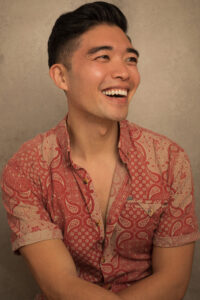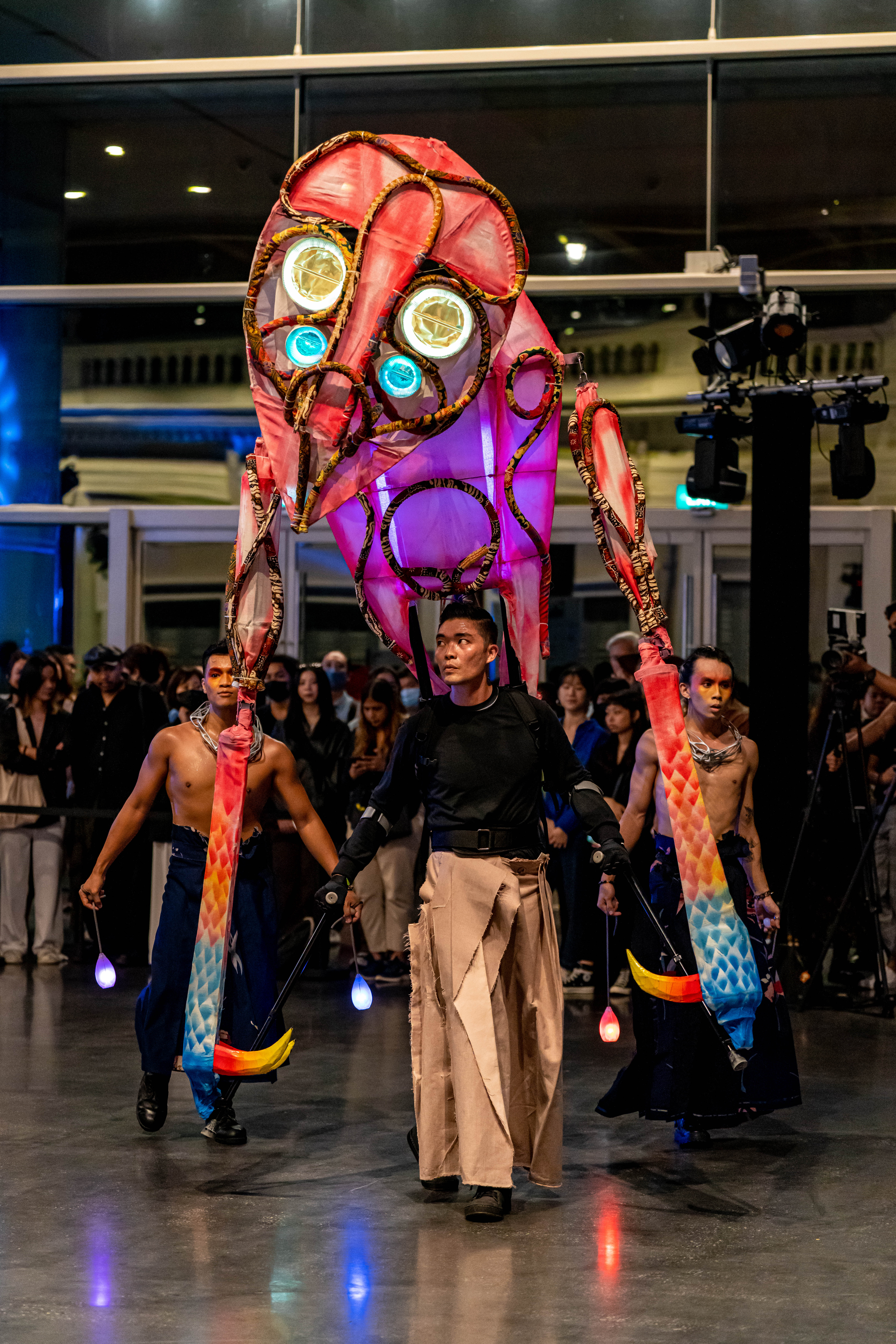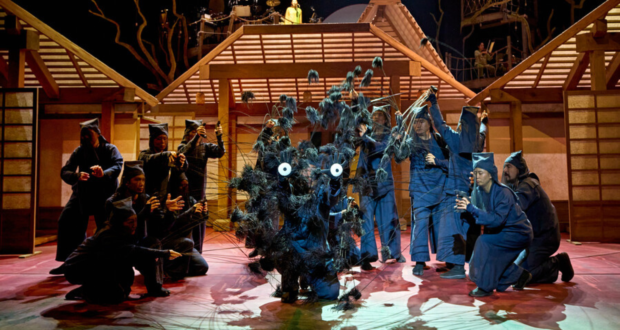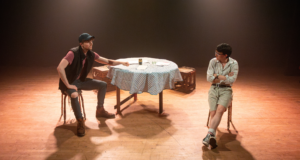Bright Ong talks about My Neighbour Totoro
Joe Hisaishi and the Royal Shakespeare Company’s My Neighbour Totoro, currently running at the Barbican, has been a jaw-dropping, sell out hit, featuring probably the most exciting woodland spirit you will see on stage this year. Its astonishing puppets are supported by a top team of international puppeteers, so we were delighted when one of them, Bright Ong, agreed to chat with us about his work beneath the puppet.
 Bright, it’s great to talk with you. Can you tell us a bit about your early years and how you developed an interest in puppetry?
Bright, it’s great to talk with you. Can you tell us a bit about your early years and how you developed an interest in puppetry?
Hi Mary! Thanks for having me here!
Like most people who shy away from the conventional, my journey with puppetry started with a large sense of curiosity, fuelled by rebellion, and fed by the need to create in my own way. Scarcity of work in Malaysia meant I had to venture out across to Singapore to become an actor, and later a puppeteer. Doing theatre in Singapore is niche as it gets, so one can only imagine how much more so puppetry is!
Without formal training, my early successes came through seizing every opportunity to immerse myself in theatre. Puppetry in particular, in all its forms, gave me a place to tell stories and create art in a way that human actors couldn’t.
My journey would not be the same without excellent mentors. Graeme Haddon helped when I worked on Pinocchio the Musical in Singapore, and later in the IAAPA award-winning Ninjago: The Realm of Shadows at Legoland Malaysia. Sean Masterson taught me about glove puppetry for the screen, and delivered the lovely quote that is permanently seared into my brain: “Puppetry is the last bit of real magic in the world”. Frankie Yeo of Mascots and Puppets Specialists in Singapore gave me not only tools and guidance in puppetry, but also invaluable support and belief.
It was ultimately going against the grain of being a “standard actor” that really opened my eyes to the world of puppets and performance-making. Some of the most impactful lessons came through artforms that weren’t necessarily puppetry related, but added more philosophies into my approaches. Learning to build puppets, getting employed as a Puppetry and Movement Director, and even producing my own shows were fertile grounds for holistic development in the art. Alongside it, being a lecturer in puppetry in Singapore, giving masterclasses in the region, was a great way to reflect upon my own practice and give back to the next generation. I also created shows for festivals worldwide. Luckily, one of those projects made it into the Newcastle Puppetry Festival’s Scratch Space programme line up, whilst another got featured on UNIMA UK’s journal, Puppet Notebook, leading to more puppetry and movement direction work.
Ever the rebel, and hungry to learn even more, here I am on my UK adventure, where I’ve had the pleasure of attending the Curious School of Puppetry, making my West End debut in Idiots Assemble: Spitting Image the Musical, and now with the RSC in My Neighbour Totoro.
Are there any puppet styles specific to your homeland of Malaysia and Singapore?
There are loads! There’s a whole documentary waiting to be made on this topic.
A lot of the traditional puppetry forms were brought over by the diaspora groups from different parts of East and South Asia. So we have everything from Wayang Kulit, whose stylistic origins are from South Asia, but adopted into the history of the Malay archipelago, to the various Chinese dialect puppetry styles (depending on which dialect, it’ll either be rod, marionette, or glove).
And back home, we do love a bit of mixing flavours when it comes to contemporary performances, so you’ll find so many genres and aesthetics mixed into contemporary puppetry styles. Quite a fair bit of both the traditional and modern styles often derive from a sense of ritual and culture; the only way to understand some of these things is to see it and feel it for yourself!
That being said, puppetry is by no means a mainstream artform, and I’ve been on a mission to create more space for it. But that’s another story for next time!



What are your favourite puppetry skills, and which productions have you used them in since you came to the UK?
This is nearly impossible to answer! But if I had to choose one, it’ll be a lesson I’ve learnt from Rene Baker who gifted us with this lovely quote at the Curious School of Puppetry: “Let the puppet tell you what it wants to do”, which I’ve held true to ever since.
So much of puppetry performance comes from respecting the fact that the puppet, for all its inanimate qualities, has much to teach us about the animation of life; recognising the signs of life, despite the fact that they are very dead. So just let them tell you what they want to do!
Totoro is an enormous success, with more than one impressive puppet starring in it. Can you tell us a bit about the challenges of manipulating them?
I can’t say too much without giving away the UK’s most well-kept theatrical secret, but I will say that, as in most cases, the challenge is often within the puppeteer(s), and not the puppet.
The puppets in Totoro are stunners, and the team that built them cannot be celebrated enough. They already tell you what they do, and want to do. It’s just up to us as puppeteers to find the flow and synergy with each other, and serve the bigger picture in the storytelling.
People often don’t see the truth in that puppeteers are subservient to the performance of the puppet. So while we may be manipulating them, the real challenge is facing the fact that the puppet itself is the one giving instructions, and we have to suppress our own will and ego to perform with them.
The cast are largely of East Asian or South East Asian origin. Does that bring new understandings of puppetry to the work in the show?
I’d like to think so! Everyone brings in their own unique experiences, and that definitely translates into the way we serve the picture through the puppets and movement.
I have found that sensibilities within theatrical performances in general are very influenced by the things we are exposed to. What we grow up with, and the cultures that we choose to align ourselves to. And not to forget, we have the wonderful Phelim McDermott leading the way with his directorial vision, and Basil Twist, Mervyn Millar, and You-Ri Yamanaka to guide us with the detailing in the puppetry and movement. It’s all a cohesive picture, flavoured with a very international understanding of the world we are recreating on stage.
What have the audiences been like? Are they all Studio Ghibli fans or are you seeing a range of people attending?
We have a great mix. Proportionally, I believe there are more Studio Ghibli otakus (Otaku is a Japanese word describing someone who subscribes to a subculture, typically in anime and manga), but overhearing conversations at the main entrance, there’s a healthy mix of people who are fans of theatre, the film, and of puppetry.
Regardless of their inclinations, their reactions are the same each and every time they lay eyes on the titular character. Young or old, nearly everyone is transformed back into a small child. And I must say, the appreciation for the work, extends to every department for bringing the magic to life on stage!
How does it feel working at such a prestigious venue as the Barbican and in a Royal Shakespeare Company production no less!?
To quote my puppet captain William Palmer from Spitting Image: “Delicious”.
It’s a beauty of a venue to be in, and getting to know London has been lovely. The fact that I’m in an RSC production today is a privilege that I am delighted to have. It’s just splendid that the new boy in town gets a chance to have a shot – payback for all the work, going against the grain of the mainstream, and the curiosity to seek out my own knowledge. Special mention goes to my agent Susie Dumbreck, who has been nothing short of supportive and open with me, and for luring me all the way across the globe to be here!
Totoro is running for some time yet. Do you plan to carry on with this show in the new year, or do you have other projects coming up?
It’s going to take a lot to pull me away from a show like this, like a space opera or something (*looks around furtively to see if any Star Wars execs are around*).
But I do intend to see the show through, and create wonderful memories with the team. There are some things on the horizon, which don’t have my signature on the dotted line yet! And there are things I wish to do for my communities around the globe. However, there’s my Instagram page which updates everything I do, no pressure, but here’s a shameless plug to follow @bright.ong if you’re curious!

Our thanks to Bright for his time in chatting to us about his career and the show. My Neighbour Totoro runs at the Barbican until 23 Mar 2024. Further information and bookings here.
 Everything Theatre Reviews, interviews and news for theatre lovers, London and beyond
Everything Theatre Reviews, interviews and news for theatre lovers, London and beyond



